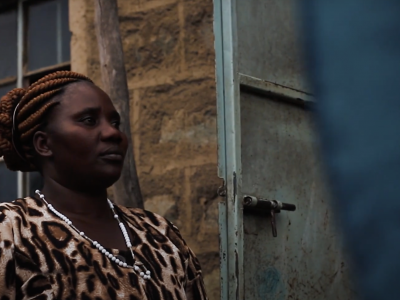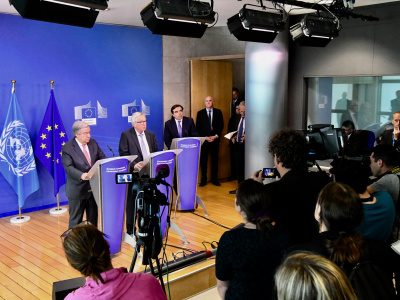
A Donor Perspective on Supporting CAADP to Promote Regional Markets for Food Security
The need for concerted action at the regional level only emerged in recent years as a key element of the Comprehensive Africa Agriculture Development Program (CAADP). Regional integration and promotion of intra-African trade were also the main themes of the last two AU summits. In the context of CAADP, development partners are called upon to step up support for regional policy formulation processes, leading to solid investment plans at the regional level to promote intra African agricultural trade and to contribute to their implementation.
Has Africa failed to deliver on intra-regional agricultural trade?
Africa as a continent has the lowest level of intra-regional trade, estimated at less than 10% of its official trade volume. By comparison, trade within Europe represents 60% of the total. The African Union is rising to the challenge of promoting intra-regional trade. The Deputy Chairperson, H.E. Erastus Mwencha, recently noted that ‘There is a strong consensus among African leaders that regional integration is indispensable to unlock economies of scale and sharpen competitiveness; and promoting intra-African trade has emerged as a top priority, in recognition that the African market of 1 billion consumers can be a very powerful engine for growth and employment’(1).
The international community and partners in Africa are engaging to promote trade corridors, production and market sheds and regional input and commodity markets. Reports by the World Bank(2) and the Food and Agriculture Organization of the United Nations (FAO(3) have highlighted the urgency to increase efforts at the regional level if food security goals are to be met. The Netherlands government has recognized this in its own development strategy for food security (Knapen/Bleker, 2011). Promoting international, regional and domestic agricultural trade is part of the Netherland’s four pronged approach to achieving food security(4). The CAADP is the platform on which initiatives to improve intra-regional agriculture related trade could be launched. Regional trade promotion is part and parcel of the CAADP agenda. It features as one of the four ‘pillars’ of the CAADP framework(5). Although the Regional Economic Communities (RECs) are working toward eliminating barriers to trade, progress has been slow.
The high cost of cross border trade in Africa has been well documented. In addition to formal and informal tariff barriers, poor infrastructure adds to the high cost of regional trade. The African Union has recently launched a continent wide infrastructure development program (PIDA, Program for Infrastructure Development in Africa) to complement existing initiatives to promote regional trade. Although tariffs do affect cross border trade, nontariff barriers, including poor infrastructure and poor investment regimes, often play an even more important role in restricting trade. PIDA has great potential to unlock regional markets, but does not yet have a specific focus on agricultural markets. The African Union Commission (AUC) and the NEPAD Planning and Coordination Agency (NPCA) are making specific efforts to ensure that infrastructure for regional agricultural markets feature as a key component of this program.
As a follow up to the recent AU Summits, the AUC and NPCA have established a joint working group with stakeholders, including the RECs and development partners .The working group will explore how CAADP can better address issues related to regional trade and infrastructure development. In this article some options for donors to move the regional trade agenda forward are proposed.
Rationale for promoting intra-regional agricultural trade
Efficient food systems depend heavily on markets that transcend borders. Agricultural production networks and food markets are not confined within national boundaries. The potentials of the wide diversity of agro-ecological zones common to Africa can only be fully exploited through promotion of regional markets. Dynamic markets for agricultural inputs and technology, and for commodities and processed products not only encourage producers to produce and invest more but also allow consumers to access the products they need for healthy lives. At the national level there are constraints that limit the effectiveness of domestic markets in improving livelihoods and food security. Moreover, in many African countries national markets are too small to give the necessary impetus to increase production and allow specialization in crops and commodities. Both input markets and consumer markets would benefit from stronger regional integration.
The volume of informal cross-border trade, estimated at almost 90% of formal trade, shows that there is a huge potential to further develop regional markets, especially in food commodities, within Africa. The growth of urban markets, especially those catering to the emerging middle class, creates huge opportunities for producers and small scale agribusiness operators, but only if they can access these markets at affordable costs. For many producers nearby markets may be ‘across the border’. Trade barriers limit access to these markets.
Developing regional markets is not a choice but an imperative to deal with food security in areas vulnerable to drought. The crises in the Horn of Africa and, more recently, in the Sahel, provide ample evidence that hunger has no borders when natural disasters and conflicts occur. The absence of effective regional markets has exacerbated the devastating effects of these natural and man-made disasters.
Regional Economic Communities hold the key
The RECs are the key actors in CAADP processes. They have two roles namely, supporting development of country level agricultural and food security policies and programs on the one hand, and designing regional programs on the other. One of the main challenges is to ensure coherence between the two and ensure that regional programs add value to national efforts and vice versa.
Although much progress has been made by the RECs to develop trade within the various regions(6), and most RECs have developed programs to support agricultural development, the linkages between these programs and the impact on agricultural development and food security are not sufficiently explored and taken advantage of. The recent AU Summits are proof that the political will to promote regional trade exists among African leaders. The challenge is to translate this into specific measures by the RECs to develop regional agricultural markets, complementing national market development strategies.
Way forward: possible roles of donors
Donor coordination around a clear agenda for regional trade in the context of CAADP could be improved. Donor working groups are active in most countries, but less so at the regional level when it comes to trade related agricultural development and food security issues. In West Africa the development partners led by Spain have established a regional donor working group to coordinate their support to the ECOWAS agricultural programme, ECOWAP/CAADP. This kind of coordination structure is yet to be replicated in other regions.
Another priority is to ensure that national and regional CAADP related policies and programs are aligned. It is only through vertical integration of agricultural development and food security related market development programs that the goals of CAADP at any level can be achieved. The RECs need to build confidence among their member states that they can deliver goods and services needed to develop national and regional agricultural input and food markets. Donors could focus more explicitly on exploring the linkages between national and regional markets.
At the headquarter level, development partners exchange information, coordinate and define support to the CAADP process at all levels, through the CAADP Development Partners Task Team (DPTT). The DPTT has initiated research and analysis to better understand the constraints RECs face when developing regional policies and programs(7). Direct support to African institutions in setting the agenda at the continental and regional level is provided through a multi-donor trust fund. The trust fund has been, and will continue to be, an important tool to assist the RECs in designing regional market development programs. However, there is also need to explore how donors can contribute financially to their implementation.
Donors could provide assistance for an inventory of donor supported programs and ‘lessons learned’ and support policy dialogues within each REC and between RECs to further develop regional policies and programs. The Netherlands, for example, contributes to an ECOWAS and UEMOA program to develop a regional input market. Donors, including The Netherlands, are also actively involved in trade corridor development and reducing trade barriers through improved legislation and regulation. Many donors support business climate reforms to facilitate cross border trade. There are valuable lessons to be learned from these experiences.
Last but not least, donors should continue to support private sector initiatives and regional farmers’ organizations involved in cross border market and trade development. Agriculture is, by definition, a private sector activity. The private sector, including farmers, has a stake in improved regional markets. Donors, governments and the RECs need to capture these dynamics and build on their strengths to improve the overall effectiveness of regional food systems.
Monique Calon is Senior Policy Advisor Food Security in the Sustainable Economic Development Department of the Netherlands Ministry of Foreign Affairs and a member of the CAADP Development Partner Task Team. Hubert Blom is Senior Policy Advisor on Trade in the Sustainable Economic Development Department of the Netherlands Ministry of Foreign Affairs.
Footnotes
1. EEAS, Link!, Number 17, 2012, Addis Ababa.
2. World Bank, 2012, De-fragmenting Africa: Deepening Regional Trade Integration in goods and Services, eds Paul Benton and Gõzde Isik
3. FAO, Trade and Markets division, 2011, Why has Africa become a Net food Importer? Exploring Africa agricultural and food trade deficits.
4. The four pillars of the Netherlands food security policy are (1) increasing production, (2) improving nutrition, (3) improving markets and (4) improving the business climate.
5. The second pillar of CAADP focuses on ‘improving rural infrastructure and trade-related capacities for market access’.
6. Including for example the tri-partite agreement between the East African Community (EAC), the Common Market for Eastern and Southern Africa (COMESA) and the Southern African Development Community (SADC),
7. In 2011, the DPTT requested ECDPM to undertake a mapping of regional CAADP in various RECs. More information available at: www.ecdpm.org/dp128
This article was published in Great Insights Volume 1, Issue 7 (September 2012)



